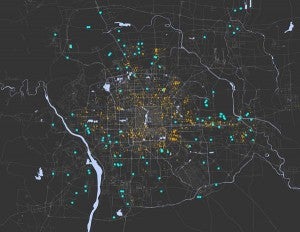Study reveals life in Beijing’s underground
 Contact: Andrew Good at (213) 740-8606 or gooda@usc.edu.
Contact: Andrew Good at (213) 740-8606 or gooda@usc.edu.
Approximately 1 million people are estimated to be renting underground apartments — a living situation that has largely remained unexamined.
A USC study is one of the few attempts to look at the housing market that exists below Beijing’s buildings. These units are often much cheaper than public housing projects, and fulfill demand despite being cramped and as much as one to two stories underground.
The study, published in the March issue of Cities, analyzed online ads for rental apartments from 2012 to 2013, mapping out where the largest concentrations of underground housing could be found. While now technically illegal, the underground rental market has filled a critical need for affordable housing for migrant laborers and young Chinese looking to start their careers.
The study highlights the need for comprehensive affordable rental housing policies in “megacities” like Beijing, said author Annette Kim of the USC Sol Price School of Public Policy.
“What this underground phenomenon is powerfully showing is that the location of housing is a priority,” Kim said. “People would even rather live underground if it means that they can be in the city, close to employment.”
Kim and a team of Chinese researchers collected more than 7,000 online ads, analyzing some 3,677 underground housing spaces among them. They parsed the data by size, cost and amenities.
The median size of the underground units was 9.73 square meters — just under the city’s regulated minimum size of 10 square meters. That’s much smaller than Beijing’s average unit size (28.8 square meters per person) but still bigger than the average worker dormitory unit (6.2 square meters).
Because landlords who advertise online are typically more educated and have better resources, the rentals Kim studied were likely on the higher end of underground options. The mean monthly rent was 448 renminbi (U.S. $70), while a 2012 government study found 48 percent of Beijing’s migrant population pays less than 300 renminbi per month (U.S. $48).
It’s tempting to think of these living conditions as substandard — and, to be sure, many of them were. But Kim noted that there was a wide range in quality, with her team finding some rentals that were relatively desirable. More than half of the advertised units had Internet access, and about a quarter mentioned security cameras. Most were near public transportation.
The tenants included waiters, store clerks and even interior designers.
“One finding that surprised me is that a lot of this underground housing is middle-quality, migrant housing,” Kim said. “We have this image of rat holes, but some are brightly lit and clean. The main thing is that being in the city center is so valuable to people.
You have less commute time, and can even hold two jobs because of it.”
Since the Cold War, basements and bomb shelters were required to be built under buildings. As far back as the ’90s, landlords started honeycombing these spaces with cheap building materials.
Over the last two decades, many rural Chinese have moved to Beijing seeking higher wages and better city services. In China, residents are assigned to specific cities, where they are registered to use that city’s educational and economic resources.
With the proper registration or without, Beijing has been an attractive draw. The migrant workers that have come to these units helped fuel a construction boom in Beijing leading up to the 2008 Olympics.
Kim’s study concludes that urban density in Asian megacities will require innovative new housing policies in the future. While conditions could be further improved with better design and regulation, clearly the need and willingness to live underground exists; further questions remain about whether this type of housing is cyclical or largely temporary.
“We need to change how we live in cities and share space,” Kim said. “There are now many more people trying to live in the city.”
This project was made possible by funding from the MIT MISTI China program. The USC Price School of Public Policy provided a year’s sabbatical at Peking University; the Peking University-Lincoln Institute Center hosted Kim as a visiting fellow.
For more images and information, please see: http://slab.today/2014/09/subterranean-urbanism-beijing/
Image caption: The orange dots show the location of the 3,385 underground rental units we found advertised for rent online during 2012-2013. Meanwhile, the blue dots show that affordable housing projects are located on the periphery. Also, only people who have hukou, the household registration permit, are eligible to apply. The roughly 10 million migrants without hukou need to find housing that they can afford. Courtesy Annette Kim.
